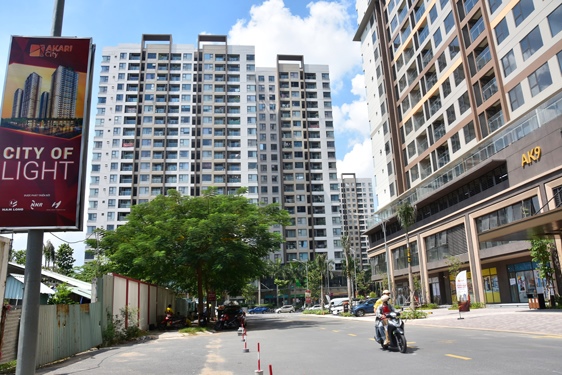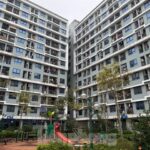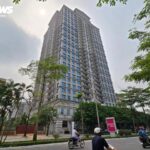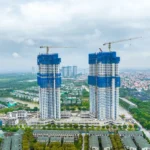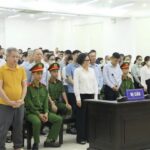At a recent meeting of the Government’s Standing Committee on the real estate market situation, the Prime Minister requested that ministries, sectors, and localities urgently identify the causes of increased real estate costs and selling prices, while removing barriers to promote healthy market development, in line with the income of the vast majority of the population.
Bottlenecks Restricting Supply
The directive from the Head of Government emphasized the need to reduce by at least 30% the time and costs involved in administrative procedures related to investment, construction, and project development. It also instructed strict handling of land speculation, market manipulation, and the creation of artificial demand.
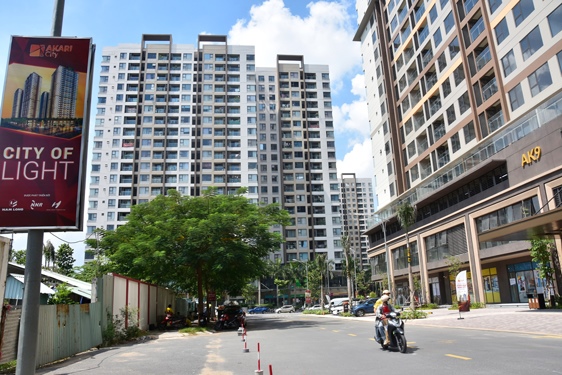
The mismatch and scarcity of moderately priced apartments have significantly impacted the market’s prices. Photo: TAN THANH |
In reality, the real estate market has not developed proportionally to its potential and continues to face prolonged bottlenecks. According to the Ministry of Construction’s report, one of the main reasons for the high real estate prices is the imbalanced product structure.
While there is an oversupply of high-end properties (villas and low-rise buildings), affordable housing is extremely scarce, especially in major cities like Hanoi and Ho Chi Minh City. Many product prices far exceed the affordability of the majority of the population, particularly those with middle and low incomes.
“House prices have risen partly due to increased input costs, especially land-related costs with the application of new price tables, along with abnormal land auction results,” said Nguyen Van Sinh, Deputy Minister of Construction.
In addition, speculation and price inflation by unprofessional brokers without qualifications have led to a lack of market transparency. “Many freelance brokers engage in unscrupulous practices, colluding to fix prices, causing harm to the people and eroding trust in the market,” the Ministry of Construction’s report stated.
From a business perspective, Dang Anh Tu, CEO of Saigon 5 Real Estate Development Joint Stock Company, attributed high real estate prices to soaring input costs. “The prolonged administrative procedures increase borrowing costs. If a project duration extends from three years to six years, total costs can rise by 20-30%, leading to a corresponding increase in selling prices,” said Tu. He emphasized that following the Prime Minister’s directive to reduce time and cost by 30% would significantly lower product prices, benefiting homebuyers.
Regarding supply and demand, Vo Hong Thang, Deputy General Director of DKRA Group, analyzed: “Real estate prices reflect a supply-demand imbalance. While there is still strong genuine housing demand, supply is constrained by legal obstacles faced by projects.” According to Thang, the efforts to resolve these issues are commendable, but compared to the prolonged stagnation, the impact of these solutions has not been strong enough to cool down the market.
Citing Ho Chi Minh City’s market as an example, DKRA Group’s May report showed that Grade A apartments accounted for 76% of new supply. Meanwhile, segments suitable for middle-income earners have hardly been developed. The city’s total consumption reached less than 1,200 units, an 11% decrease compared to the same period, indicating weak actual purchasing power despite price stabilization after the 2021-2022 surge.
The Ministry of Construction’s report for the first quarter of 2025 showed that only 3,813 commercial housing units were completed nationwide, a 40% increase from the same period but still insufficient to meet demand. Notably, while real estate credit reached over VND 1,560 trillion, a 7% increase from the fourth quarter of 2024, disbursement faced challenges due to enterprises’ lack of collateral, and many projects’ incomplete legal procedures.
Additionally, the instability of financial markets such as stocks, gold, and bonds has led to continued capital inflows into real estate, creating upward price pressure despite subdued transaction activities. The absence of a land price database also complicates land price determination for management agencies and enterprises, further prolonging project implementation and increasing costs.
Unblocking Legal Constraints to Facilitate Capital Flow
Given the market’s obstacles, the Government Standing Committee has assigned relevant agencies to urgently review, amend, and remove inconsistent and inappropriate regulations. The focus should be on common bottlenecks such as suspended planning, land price determination, land use conversion, investment appraisal, and construction permitting.
According to the 1435 Task Force’s statistics, there are currently 788 real estate projects facing difficulties, with only 136 resolved, or 17.3%. Notably, 251 projects, or over 40% of the total, encounter land-related issues. This highlights that addressing land-related constraints and investment procedures is crucial to increasing supply and reducing prices.
In terms of credit policies, the State Bank has been assigned to direct commercial banks to focus on disbursement for commercial housing projects with reasonable prices and explore a dedicated credit package for first-time young homebuyers. Emphasis has also been placed on reducing borrowing conditions to facilitate access to capital for both enterprises and homebuyers.
Additionally, there is a need to完善 the legal framework for housing, urban planning, investment and construction, and real estate business. The Ministry of Construction is collaborating with the National Assembly to develop a resolution on pilot mechanisms for social housing development. Facilitating capital flow into this segment will address the housing needs of middle and low-income groups, who constitute a significant portion of the population but are often overlooked in the market.
A notable proposal is to increase post-inspection and reduce pre-inspection. Instead of requiring numerous procedures at the beginning, some requirements can be shifted to the later stages, helping shorten investment timelines while ensuring project quality and legal compliance.
“If projects continue to take 3-5 years to complete all procedures before construction, costs will inevitably rise. Policies to expand supply as soon as possible should be prioritized,” emphasized Vo Hong Thang.
It is also essential to enhance the capacity to monitor and strictly handle market manipulation and artificial demand creation. The Ministry of Construction proposed tightening the operations of unprofessional individual and group brokers and raising professional standards to ensure transparency. Establishing a unified and transparent market data system is crucial for better controlling prices and transaction activities.
With the economic growth target set at 8% for 2025 and double digits in subsequent years, ensuring a stable and sustainable real estate market is not only an economic imperative but also a social welfare concern. Therefore, unblocking legal constraints, reforming administrative procedures, rebalancing the product structure, and facilitating capital flow will be the critical “sweet spots” to cool down housing prices and bring real estate closer to the actual demand.
SON NHUNG
“State-owned Enterprises Should Focus on Affordable Housing”
“Experts advocate for opening up the real estate market to state-owned enterprises, believing it will benefit the industry. They suggest that these enterprises focus on providing affordable housing to low-income earners in major cities, thus improving their living standards and overall well-being.”
“The Rising Cost of Real Estate: Unraveling the Mystery”
The Government requires an urgent review to identify the factors contributing to the rise in real estate prices, including land prices, material costs, and interest rates. It is imperative to devise strategies to mitigate these price-driving factors, enhance accessibility, and boost supply to address this pressing issue.
“Unveiling the Factors Behind Soaring Real Estate Prices”
The Government requires an immediate investigation into the factors contributing to the rise in real estate prices, including land costs, material prices, and interest rates, among other factors. It is imperative to devise strategies that effectively reduce these price-driving elements, thereby enhancing accessibility and increasing the supply of real estate options.


























